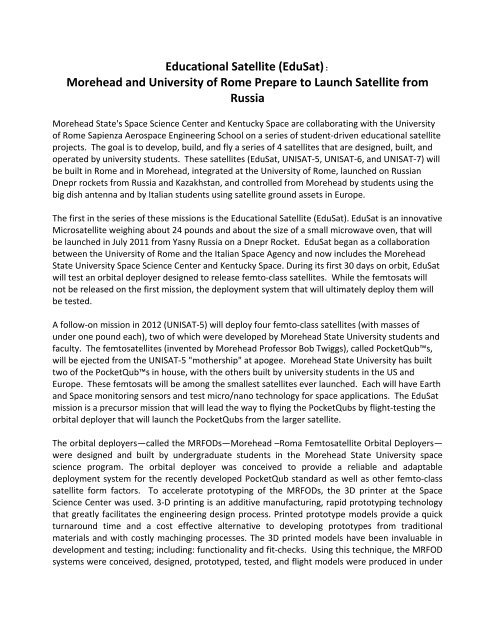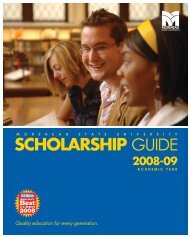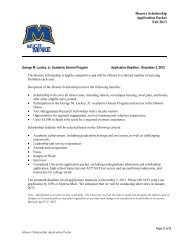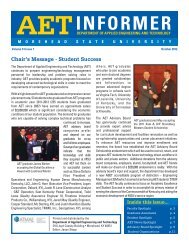Morehead and University of Rome Prepare to Launch Satellite from ...
Morehead and University of Rome Prepare to Launch Satellite from ...
Morehead and University of Rome Prepare to Launch Satellite from ...
Create successful ePaper yourself
Turn your PDF publications into a flip-book with our unique Google optimized e-Paper software.
Educational <strong>Satellite</strong> (EduSat):<strong>Morehead</strong> <strong>and</strong> <strong>University</strong> <strong>of</strong> <strong>Rome</strong> <strong>Prepare</strong> <strong>to</strong> <strong>Launch</strong> <strong>Satellite</strong> <strong>from</strong>Russia<strong>Morehead</strong> State's Space Science Center <strong>and</strong> Kentucky Space are collaborating with the <strong>University</strong><strong>of</strong> <strong>Rome</strong> Sapienza Aerospace Engineering School on a series <strong>of</strong> student‐driven educational satelliteprojects. The goal is <strong>to</strong> develop, build, <strong>and</strong> fly a series <strong>of</strong> 4 satellites that are designed, built, <strong>and</strong>operated by university students. These satellites (EduSat, UNISAT‐5, UNISAT‐6, <strong>and</strong> UNISAT‐7) willbe built in <strong>Rome</strong> <strong>and</strong> in <strong>Morehead</strong>, integrated at the <strong>University</strong> <strong>of</strong> <strong>Rome</strong>, launched on RussianDnepr rockets <strong>from</strong> Russia <strong>and</strong> Kazakhstan, <strong>and</strong> controlled <strong>from</strong> <strong>Morehead</strong> by students using thebig dish antenna <strong>and</strong> by Italian students using satellite ground assets in Europe.The first in the series <strong>of</strong> these missions is the Educational <strong>Satellite</strong> (EduSat). EduSat is an innovativeMicrosatellite weighing about 24 pounds <strong>and</strong> about the size <strong>of</strong> a small microwave oven, that willbe launched in July 2011 <strong>from</strong> Yasny Russia on a Dnepr Rocket. EduSat began as a collaborationbetween the <strong>University</strong> <strong>of</strong> <strong>Rome</strong> <strong>and</strong> the Italian Space Agency <strong>and</strong> now includes the <strong>Morehead</strong>State <strong>University</strong> Space Science Center <strong>and</strong> Kentucky Space. During its first 30 days on orbit, EduSatwill test an orbital deployer designed <strong>to</strong> release fem<strong>to</strong>‐class satellites. While the fem<strong>to</strong>sats willnot be released on the first mission, the deployment system that will ultimately deploy them willbe tested.A follow‐on mission in 2012 (UNISAT‐5) will deploy four fem<strong>to</strong>‐class satellites (with masses <strong>of</strong>under one pound each), two <strong>of</strong> which were developed by <strong>Morehead</strong> State <strong>University</strong> students <strong>and</strong>faculty. The fem<strong>to</strong>satellites (invented by <strong>Morehead</strong> Pr<strong>of</strong>essor Bob Twiggs), called PocketQubs,will be ejected <strong>from</strong> the UNISAT‐5 "mothership" at apogee. <strong>Morehead</strong> State <strong>University</strong> has builttwo <strong>of</strong> the PocketQubs in house, with the others built by university students in the US <strong>and</strong>Europe. These fem<strong>to</strong>sats will be among the smallest satellites ever launched. Each will have Earth<strong>and</strong> Space moni<strong>to</strong>ring sensors <strong>and</strong> test micro/nano technology for space applications. The EduSatmission is a precursor mission that will lead the way <strong>to</strong> flying the PocketQubs by flight‐testing theorbital deployer that will launch the PocketQubs <strong>from</strong> the larger satellite.The orbital deployers—called the MRFODs—<strong>Morehead</strong> –Roma Fem<strong>to</strong>satellite Orbital Deployers—were designed <strong>and</strong> built by undergraduate students in the <strong>Morehead</strong> State <strong>University</strong> spacescience program. The orbital deployer was conceived <strong>to</strong> provide a reliable <strong>and</strong> adaptabledeployment system for the recently developed PocketQub st<strong>and</strong>ard as well as other fem<strong>to</strong>‐classsatellite form fac<strong>to</strong>rs. To accelerate pro<strong>to</strong>typing <strong>of</strong> the MRFODs, the 3D printer at the SpaceScience Center was used. 3‐D printing is an additive manufacturing, rapid pro<strong>to</strong>typing technologythat greatly facilitates the engineering design process. Printed pro<strong>to</strong>type models provide a quickturnaround time <strong>and</strong> a cost effective alternative <strong>to</strong> developing pro<strong>to</strong>types <strong>from</strong> traditionalmaterials <strong>and</strong> with costly machinging processes. The 3D printed models have been invaluable indevelopment <strong>and</strong> testing; including: functionality <strong>and</strong> fit‐checks. Using this technique, the MRFODsystems were conceived, designed, pro<strong>to</strong>typed, tested, <strong>and</strong> flight models were produced in under
9 months. Using traditional manufacturing processes for pro<strong>to</strong>typing the engineering modelswould have taken significantly longer <strong>and</strong> would have cost several times as much <strong>to</strong> produce.The PocketQub is a new satellite st<strong>and</strong>ard that was proposed in 2009 by Pr<strong>of</strong>essor Robert Twiggsfor a satellite even smaller than the CubeSat. PocketQubs are 5 cm cubes <strong>and</strong> can literally fit in apocket. The PocketQub leverages the CubeSat st<strong>and</strong>ard <strong>and</strong> also leverages the revolution in theminiaturization <strong>of</strong> electronics. PocketQubs will ultimately have a wide range <strong>of</strong> applicationsincluding: Network Nodes, Sensor Systems, <strong>Satellite</strong> Constellations, Inexpensive, Redundant,Spatially Organized Earth Remote Sensing Platforms.Students <strong>of</strong> the Space Science Center (SSC) at <strong>Morehead</strong> State <strong>University</strong> served as the principleengineers in the development <strong>of</strong> two <strong>of</strong> the first PocketQubs (Eagle‐1 <strong>and</strong> Eagle‐2) <strong>and</strong> the<strong>Morehead</strong>‐<strong>Rome</strong> Fem<strong>to</strong>Sat Orbital Deployers (FOD) designed <strong>to</strong> deploy the fem<strong>to</strong>sats <strong>from</strong> Edusat(the mother ship). Eagle‐1 <strong>and</strong> 2 will test deployable de‐orbit systems <strong>and</strong> establish flight heritagefor fem<strong>to</strong>sat systems including power systems <strong>and</strong> transceivers. The primary payloads on EduSatare environmental sensors dedicated <strong>to</strong> secondary education research. The EduSat‐FOD mission’ssuccessful launch <strong>and</strong> operation will potentially usher in a new frontier in micro‐miniaturization <strong>of</strong>technologies for the small satellite industry.The series <strong>of</strong> space missions are educational <strong>and</strong> research space mission involving the <strong>University</strong> <strong>of</strong><strong>Rome</strong> Sapienza, Kentucky Space <strong>and</strong> <strong>Morehead</strong> State <strong>University</strong>. The on‐going project has twomain purposes: designing, building, <strong>and</strong> launching a student‐built satellite <strong>and</strong> testing pro<strong>to</strong>typetechnologies including extremely small space systems in the space environment. Students at the<strong>University</strong> <strong>of</strong> <strong>Rome</strong> <strong>and</strong> <strong>Morehead</strong> have had the responsibility <strong>of</strong> designing the satellite’smechanical systems, electronics systems, s<strong>of</strong>tware systems, <strong>and</strong> will operate the satellites onorbit. The missions provide excellent opportunities for students <strong>to</strong> engage in research <strong>and</strong> at thesame time push the envelope <strong>of</strong> micro‐nano technologies for space applications.Dr. Malphrus, Direc<strong>to</strong>r <strong>of</strong> the Space Science Program, Kevin Brown, Assistant Pr<strong>of</strong>essor <strong>of</strong> SpaceScience, <strong>and</strong> two undergraduate students—Nathan Fite <strong>and</strong> Tyler Rose will travel <strong>to</strong> Italy for theintegration activities <strong>and</strong> Dr. Malphrus <strong>and</strong> Kevin Brown will travel <strong>to</strong> Russia for the launch. Agroup <strong>of</strong> students including Clay Graves, Jonathan Fitzpatrick, Ben Cahall, Caleb Grimes, <strong>and</strong>Margaret Powell will serve as the ground operations team for launch <strong>and</strong> early operations <strong>of</strong> thesatellite <strong>from</strong> the MSU Mission Operations Center.
Undergraduate Space Science Student Nathan Fite holding a PocketQub <strong>Satellite</strong>
Dr. Malphrus examining one <strong>of</strong> the <strong>Morehead</strong>‐<strong>Rome</strong> Fem<strong>to</strong>sat Orbital Deployers (MRFODs) thatare installed in the EduSat microsatellite <strong>and</strong> will ultimately eject fem<strong>to</strong>satellites developed bystudents at <strong>Morehead</strong> State <strong>University</strong> <strong>and</strong> the <strong>University</strong> <strong>of</strong> <strong>Rome</strong>
Tyler Rose, a Space Science Student, <strong>Prepare</strong>s One FOD Unit for Vibration Testing
Interior View <strong>of</strong> MRFOD Deployment Rails & Electronics Package
Fit Check <strong>of</strong> a PocketQub <strong>Satellite</strong> in the MRFOD System
















